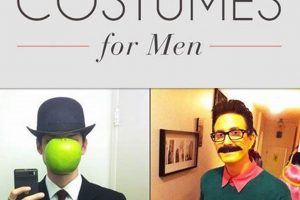A homemade inmate outfit typically involves replicating the visual elements associated with incarcerated individuals. This often includes striped or orange garments, sometimes bearing identification numbers or institution names. Construction can utilize readily available materials like old clothing, fabric paint, and simple sewing techniques. For instance, an individual might adapt an old t-shirt and pants by painting black and white stripes onto them to simulate a classic prison uniform.
The appeal of creating such an ensemble stems from its affordability and customizability. Individuals can tailor the fit and design to their specific preferences. Furthermore, these creations are often favored for costume parties, theatrical productions, or themed events. Historically, the appearance of prisoners has varied, but the striped uniform became a recognizable symbol of incarceration in the 19th century, contributing to the costume’s enduring popularity.
The subsequent sections will elaborate on specific methods for constructing these outfits, detailing material options, customization techniques, and safety considerations relevant to their creation. Detailed guidance on replicating authentic institutional markings and adding realistic accessories will also be provided.
Construction Guidelines
The following recommendations address critical aspects of creating a homemade inmate outfit, ensuring both realism and safety.
Tip 1: Fabric Selection: Opt for durable, comfortable fabrics like cotton or a cotton blend. This ensures the wearer’s comfort, particularly for extended wear at events. Avoid synthetic materials that may cause overheating or irritation.
Tip 2: Stripe Application: If recreating a striped uniform, use fabric paint specifically designed for textiles. Apply multiple thin coats rather than one thick coat to prevent cracking and ensure longevity of the design. Mark stripe positions with measuring tools and light pencil markings for accuracy.
Tip 3: Color Adherence: For an orange uniform, select a shade closely matching standard correctional facility attire. Referencing images of actual prison uniforms can provide guidance on achieving color authenticity. Proper dying or painting techniques should be applied to prevent color bleeding.
Tip 4: Identification Numbering: Consider incorporating an inmate identification number for added realism. Stencil kits and fabric markers are effective tools for applying these numbers. Choose a series of digits that avoids resemblance to actual inmate numbers.
Tip 5: Accessory Selection: Handcuff props, while adding to the aesthetic, should be lightweight and pose no safety risk. Avoid metal or overly restrictive models. Consider using plastic alternatives or opting for striped socks instead.
Tip 6: Size and Fit: Accurate measurements are critical. Ensure the garment allows for ease of movement. A loose-fitting design enhances both authenticity and wearer comfort, preventing any perception of confinement.
Tip 7: Laundering Precautions: Hand-wash the finished garment in cold water with a mild detergent to preserve the fabric paint or dye. Avoid using bleach, which can degrade colors and materials. Air-dry the costume to prevent shrinking or damage.
Adhering to these guidelines will improve the overall quality, authenticity, and safety of the resulting creation. These tips promote a realistic appearance while ensuring user comfort and longevity of the homemade garment.
The subsequent section will discuss advanced customization options, including weathering techniques and prop enhancements, to further elevate the design’s realism.
1. Affordability
Cost considerations are a primary driver in the decision to create a homemade inmate outfit. The readily available nature of base materials and the avoidance of retail markups make it a financially appealing alternative to commercially produced costumes.
- Material Sourcing and Repurposing
Affordability is intrinsically linked to the utilization of pre-existing materials. Individuals often repurpose old clothing, fabric remnants, or household items to construct the costume, eliminating the need for new purchases. This approach significantly reduces the overall cost, particularly compared to purchasing a new, pre-made garment.
- Reduced Labor Costs
The do-it-yourself approach eliminates external labor costs associated with manufacturing and retail. The individual assumes responsibility for all stages of the creation process, from design to assembly. This self-sufficiency translates directly into cost savings, as there are no wages or fees to pay beyond the expense of raw materials.
- Customization vs. Commercial Options
Commercial costume options often lack the desired level of customization and may be subject to inflated prices due to branding and licensing. Creating a homemade version allows for tailoring the outfit to specific preferences and measurements without incurring additional costs associated with alterations or bespoke orders. This provides greater control over both the aesthetics and the budget.
- Resourcefulness and Creativity
The pursuit of affordability often fosters resourcefulness and creativity in the design and construction process. Individuals may experiment with unconventional materials, innovative techniques, and thrifty alternatives to achieve the desired look without exceeding a predetermined budget. This improvisational aspect further enhances the appeal of the do-it-yourself approach.
Ultimately, the intersection of cost consciousness and creative problem-solving defines the “diy prisoner costume”. The ability to control expenses, leverage readily available resources, and personalize the design makes it a compelling choice for individuals seeking an affordable and unique costume solution. By making smart decisions during the construction process such as fabric selection this becomes a more suitable costume.
2. Recognizability
The inherent success of a homemade inmate outfit hinges substantially on its recognizability. The costume’s effectiveness as a form of representation is directly proportional to its ability to be immediately identified and understood by observers. This necessitates adherence to established visual codes and symbolic markers commonly associated with incarcerated individuals. The absence of such discernible features renders the costume ambiguous and diminishes its intended impact. For example, a simple orange jumpsuit, without any further embellishments, readily conveys the intended theme due to the widespread association of orange with prison uniforms in contemporary media and popular culture. Conversely, an ensemble lacking these recognizable elements, despite its construction quality, fails to communicate the intend
ed concept effectively.
The recognizability of such a costume is not merely a matter of aesthetic accuracy, but also a function of cultural context and shared understanding. The visual cues that signal “prisoner” are often reinforced through film, television, and news media, creating a collective mental image of what a typical inmate looks like. Therefore, the closer the homemade outfit aligns with these pre-existing perceptions, the more readily it will be recognized and understood. Consider the widespread adoption of black and white striped uniforms in 19th-century prisons; this image has been perpetuated through various media, leading to instant recognition even in contemporary settings. However, the choice of an obscure or historically inaccurate uniform design would significantly reduce the costume’s immediate impact, requiring more explanation to convey the intended meaning.
In conclusion, recognizability forms a crucial component of the do-it-yourself inmate costume. Its importance stems from its ability to communicate effectively and instantaneously. While creativity and personalization are valuable, they should not come at the expense of clarity. The challenge lies in striking a balance between originality and adherence to established visual conventions, ensuring that the costume is both unique and immediately comprehensible. Failure to prioritize recognizability undermines the fundamental purpose of the costume, rendering it ineffective as a means of representation.
3. Customization
Within the realm of self-constructed inmate attire, customization represents a spectrum of personalized alterations and modifications that elevate the design beyond mere replication of institutional garments. It permits individual expression and fine-tuning to match specific event requirements or personal preferences.
- Personalization of Identification Markings
The inclusion of inmate numbers or institutional insignias provides opportunities for personalization. Individuals might incorporate fictional names, significant dates, or humorous alphanumeric sequences, thereby imbuing the costume with a unique identifier that moves beyond generic representations. The choice of font, size, and placement of these markings further contributes to the distinctiveness of the outfit.
- Adaptation of Garment Style and Fit
Departing from standard prison uniform designs allows for modifications to the garment’s cut and silhouette. Varying the length of sleeves, adjusting the width of pant legs, or incorporating unconventional closures enables a more tailored and individualistic look. Such alterations can reflect the wearer’s personal style or address specific comfort considerations.
- Application of Distressing and Weathering Effects
Adding simulated wear and tear, such as dirt smudges, frayed edges, or simulated tears, enhances the costume’s realism and narrative potential. These effects can suggest prolonged confinement or specific events within a fictional inmate’s history. The application of these techniques requires careful consideration of the intended backstory and should be implemented with a degree of subtlety to avoid caricature.
- Integration of Thematic Accessories
Beyond the core garment, the incorporation of accessories offers another avenue for customization. Plastic handcuffs, imitation shanks (handled with extreme caution and awareness of legal restrictions), or personalized prop items can contribute to a more complete and nuanced portrayal. These additions allow for storytelling and the creation of a more immersive character.
These distinct facets emphasize that this type of costume isn’t merely about mimicking but about expressing individuality within a well-defined theme. By understanding and applying these options, individuals can transform a basic garment into a unique and compelling representation.
4. Material Sourcing
Material acquisition constitutes a foundational aspect of constructing a homemade inmate outfit. The selection and procurement of suitable components directly influence the costume’s visual fidelity, durability, and overall cost-effectiveness. Responsible material sourcing, therefore, becomes crucial for both the aesthetic and practical success of the endeavor.
- Repurposed Textiles and Existing Garments
The utilization of pre-owned clothing and fabric remnants stands as a common strategy in material sourcing. Discarded garments, thrift store finds, and fabric scraps provide cost-effective alternatives to purchasing new materials. This approach often aligns with principles of sustainability and resourcefulness, reducing environmental impact while minimizing expenses. For example, an old pair of work pants might be easily dyed orange, while a long sleeve shirt can have stripes added using fabric paint.
- Economical Fabric Procurement
When new fabric acquisition becomes necessary, prioritizing economical options ensures budget adherence. Discount fabric retailers, online marketplaces, and bulk purchases often offer cost savings. Selecting durable and easily washable materials, such as cotton blends, contributes to the costume’s longevity. Purchasing fabric in larger quantities, even when not entirely needed for a single project, can yield long-term savings if future projects are anticipated.
- Paint and Dye Selection
The choice of appropriate paints and dyes directly affects the visual authenticity and durability of the costume. Fabric-specific paints and dyes are essential for preventing color bleeding and ensuring long-lasting adhesion. Selecting colorfast options minimizes fading and discoloration over time. Furthermore, considering the application method, whether brush, spray, or immersion dyeing, influences the choice of product and required safety precautions.
- Hardware and Accessory Acquisition
The procurement of supplementary hardware and accessories, such as buttons, zippers, and decorative elements, requires careful consideration of both cost and realism. Sourcing these items from discount retailers, craft stores, or online suppliers can yield significant savings compared to specialty costume shops. Selecting durable and appropriate materials ensures that these components withstand wear and tear, contributing to the overall longevity of the homemade inmate outfit.
The deliberate and informed acquisition of materials directly shapes the character and lifespan of the constructed inmate outfit. By focusing on resourceful strategies and cost-effective options, creators can achieve visually compelling and durable costumes while minimizing financial investment. The interplay between material sourcing and creative adaptation underscores the essence of do-it-yourself costume design.
5. Safety
The construction of homemade inmate attire, while often undertaken for recreational purposes, necessitates careful attention to safety protocols. The potential for misuse or misinterpretation of such costumes requires proactive measures to mitigate risks and ensure responsible use.
- Prop Weaponry and Simu
lated ViolenceThe inclusion of prop weaponry, such as simulated knives or firearms, introduces significant safety concerns. Realistic-looking replicas can be mistaken for genuine weapons, potentially leading to alarm or intervention by law enforcement. Furthermore, the enactment of simulated violence, even in a playful context, can be misconstrued or cause unintended harm. Prop weapons should be clearly identifiable as non-functional and handled with extreme caution to prevent accidental injury or misrepresentation. For example, orange tips are often added to toy guns so they are not confused for real guns.
- Restraints and Simulated Confinement
The use of simulated restraints, such as handcuffs or shackles, poses risks of accidental injury or discomfort. Overly restrictive or poorly designed restraints can impede circulation, cause skin irritation, or restrict movement. Furthermore, the act of simulating confinement, even in jest, can trigger anxiety or claustrophobia in some individuals. Restraints should be constructed from lightweight, flexible materials and designed to allow for easy removal in case of emergency. The user should also be cautious of those around them, as they don’t know their conditions or past traumas.
- Misidentification and Security Concerns
The visual resemblance of a homemade inmate outfit to actual correctional attire can create confusion or raise security concerns in certain environments. Wearing such a costume in or near correctional facilities, courthouses, or other sensitive locations can be misinterpreted as an attempt to impersonate an inmate or disrupt security protocols. It is imperative to exercise discretion and avoid wearing the costume in situations where it could be misconstrued or cause alarm. This becomes more important if the costume looks too similar to real inmate uniforms. The wearer should always have a disclaimer on hand.
- Material Toxicity and Flammability
The selection of materials used in the construction of the costume should prioritize non-toxic and flame-retardant options. Certain paints, dyes, and fabrics can release harmful chemicals or pose a fire hazard. Thoroughly research the properties of all materials before use and follow manufacturer’s instructions for safe handling and application. Avoid using materials that are known to be flammable or that emit noxious fumes when heated or burned.
These considerations collectively emphasize the importance of responsible planning and execution in the creation and use of homemade inmate attire. By proactively addressing potential safety hazards and exercising sound judgment, individuals can minimize risks and ensure that the costume serves its intended purpose without causing harm or misrepresentation.
6. Durability
Durability constitutes a critical element in the creation and longevity of a homemade inmate outfit. The materials and construction techniques employed directly influence the costume’s ability to withstand repeated use, washing, and potential wear and tear. Low-quality materials or inadequate construction can lead to premature damage, diminishing the costume’s aesthetic appeal and functional lifespan. For instance, using inexpensive fabric paint prone to cracking will necessitate frequent touch-ups, while weak seams may unravel under stress, requiring repairs. This emphasizes the need for careful material selection and robust construction to ensure the outfit can endure the demands of its intended use.
The practical significance of durability extends beyond mere aesthetic considerations. A durable costume requires less frequent replacement, translating to cost savings over time. Furthermore, a well-constructed outfit can withstand more rigorous activities, such as theatrical performances or costume parties, without succumbing to damage. Consider a scenario where a poorly constructed costume tears during a performance; the resulting distraction can detract from the overall presentation. Conversely, a durable costume built with reinforced seams and resilient materials will withstand the physical demands of the performance, maintaining its integrity and contributing to a seamless presentation.
In summary, durability is inextricably linked to the overall value and utility of a homemade inmate outfit. It affects not only the costume’s appearance and longevity but also its functionality and cost-effectiveness. Prioritizing durable materials and sound construction techniques ensures that the outfit can withstand the rigors of use, minimizing the need for repairs or replacements. This focus ultimately maximizes the investment and enhances the overall satisfaction derived from the creation. Challenges may include higher upfront material costs, however, these are offset by the long term value, minimizing repetitive work, and increasing use cases.
7. Authenticity
Authenticity, within the context of a homemade inmate outfit, represents the degree to which the costume convincingly mirrors the visual characteristics of actual prison attire. This extends beyond mere replication of color schemes and basic garment shapes to encompass nuanced details that contribute to a credible representation. The pursuit of authenticity stems from a desire to create a compelling and believable portrayal, enhancing the costume’s impact and effectiveness. For example, the inclusion of accurate institutional markings, such as a specific prison’s abbreviated name or a realistic inmate identification number, directly contributes to the costume’s perceived authenticity. Conversely, omitting these details or employing generic symbols diminishes the overall impression.
The importance of authenticity as a component of a self-constructed inmate uniform is multifaceted. Firstly, it reinforces the intended theme, ensuring immediate recognition and comprehension by observers. A highly authentic costume requires minimal explanation, conveying its message through visual cues alone. Secondly, authenticity can enhance the wearer’s experience, fostering a greater sense of immersion and role-playing. Knowing that the costume is accurate and detailed can boost confidence and contribute to a more convincing performance. Thirdly, the pursuit of authenticity encourages meticulous research and attention to detail, leading to a more satisfying and rewarding creation process. For example, studying historical photographs of prison uniforms can reveal subtle variations in design and construction, informing the choices made during the costume’s creation. The addition of faux prison tattoos will also further add to the realism of the prison outfit.
Ultimately, authenticity serves as a cornerstone of a successful creation. It elevates the costume from a simple imitation to a thoughtful and impactful representation. However, the pursuit of authenticity must be balanced with considerations of safety and respect. Avoiding overly realistic weapon props and refraining from wearing the costume in sensitive locations are crucial steps in mitigating potential risks and preventing misinterpretations. As such, the ethical considerations play a significant role in the overall design process. By approaching the creation of an inmate outfit with careful attention to detail and a responsible mindset, individuals can achieve a balance between authenticity and appropriateness, resulting in a costume that is both compelling and conscientious.
Frequently Asked Questions
The following addresses co
mmon inquiries and misconceptions surrounding the creation and utilization of homemade inmate attire.
Question 1: What are the key distinguishing features of an authentic-looking homemade prisoner costume?
Authenticity is achieved through accurate replication of institutional colors (often orange or striped), inclusion of identification numbers or facility insignias, and attention to garment style. Generic attire lacking these features may not be readily identifiable.
Question 2: Is it permissible to create and wear a “diy prisoner costume” in any public location?
Discretion is advised. Wearing such a costume near correctional facilities, courthouses, or other sensitive locations can be misconstrued or cause alarm. Public perception and potential security concerns should be carefully considered.
Question 3: What materials are best suited for constructing a durable and comfortable “diy prisoner costume”?
Durable, breathable fabrics like cotton or cotton blends are recommended. Fabric paints specifically designed for textiles ensure long-lasting color adhesion. Avoid synthetic materials that can cause overheating or irritation.
Question 4: How can prop weaponry be safely incorporated into a “diy prisoner costume”?
Prop weapons should be clearly identifiable as non-functional and handled with extreme caution. Realistic-looking replicas can be mistaken for genuine weapons, potentially leading to dangerous situations. Consider opting for less realistic or stylized alternatives.
Question 5: What are the ethical considerations involved in creating and wearing a “diy prisoner costume”?
Respectful representation is paramount. Avoid perpetuating harmful stereotypes or glorifying criminal behavior. Be mindful of the potential impact on individuals who may have been directly affected by incarceration.
Question 6: How can customization enhance the realism and impact of a “diy prisoner costume”?
Personalized inmate numbers, simulated wear and tear, and thematic accessories can contribute to a more compelling and believable portrayal. These details should be carefully considered and implemented to enhance, not detract from, the overall impression.
In summary, a successful “diy prisoner costume” balances authenticity, safety, and ethical considerations. Thoughtful planning and responsible execution are crucial for achieving a visually compelling and ethically sound creation.
The subsequent section will delve into the historical evolution of prison uniforms and their influence on contemporary costume design.
Conclusion
This exploration has dissected the multifaceted aspects of a homemade inmate outfit, emphasizing the interplay between affordability, recognizability, customization, material sourcing, safety considerations, durability expectations, and the pursuit of authenticity. Each facet contributes uniquely to the final product, shaping its visual impact, functionality, and overall value. Understanding these elements allows for informed decision-making during the design and construction phases.
The creation of a “diy prisoner costume” presents a complex undertaking that extends beyond mere construction. As such, responsible practices and an understanding of social impact is needed. The resulting creation can function as more than just a costume; it becomes a statement reflecting creativity, resourcefulness, and ethical awareness. Further development in material technologies and digital design tools may further refine the ease, safety, and realism of these creations, however, that doesn’t negate the need for thoughtful application.







